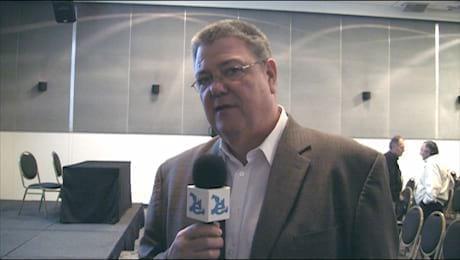semen handling
Handling of Frozen Semen Straws
Published: December 17, 2012
By: Mel DeJarnette, Senior Reproductive Specialist, Raymond Nebel, Senior Reproductive Specialist.
Proper semen handling is essential to maintain optimum reproductive performance of your AI breeding program. To maintain the high quality of semen you purchased from your Select Sires representative, you must pay strict attention to the many details of semen handling outlined is this brochure.
SEMEN PACKAGING AND STORAGE
Select Sires packages conventional semen in ½ milliliter straws. Gender Selected semen and imported semen are only available in ¼ cc straws. Handling procedures are the same for both sizes. The five-inch straw is placed in a goblet with four other straws from the same bull. Two goblets are clipped onto a metal cane. The cane is identified with the bull's code number printed on top. Canes of semen are stored in the canisters of specially designed liquid nitrogen tank refrigerators.
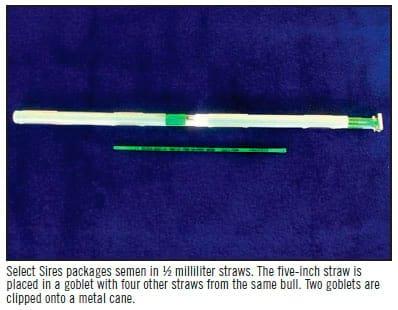
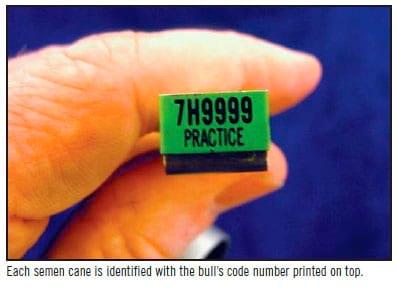
"Strict adherence to the procedures described in this brochure will maximize the opportunity for success in your AI program. If you have questions about the correct handling procedures for Select Sires semen, please call your Select Sires Reproductive Solutions Specialist."
SEMEN TRANSFER
At the time of purchase, a cane of semen is transferred to the herd's liquid nitrogen tank. Tanks should be placed side by side so transfer can take place within a few seconds. Straws should remain immersed in a goblet with liquid nitrogen and not transferred individually without protection.
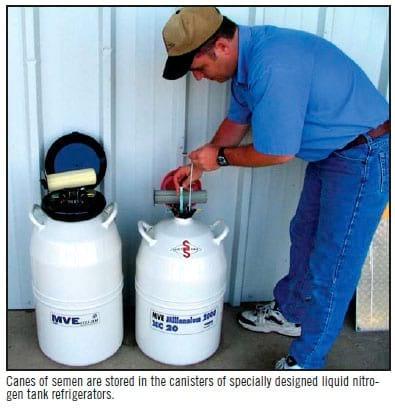
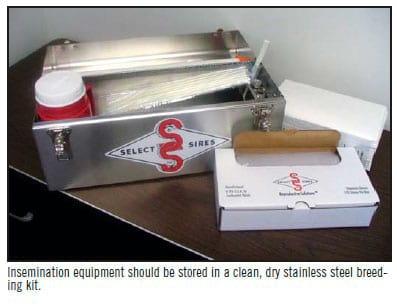
INSEMINATION EQUIPMENT
The following equipment is needed to insure proper semen storage, straw handling, and insemination procedures. This equipment should be stored in a clean, dry, stainless steel breeding kit.
• Forceps for removing straws from the tank.
• One-pint, insulated, wide-mouthed thermos with a dial thermometer for thaw water.
• Sharp stainless steel scissors for cutting straws.
• Paper towels.
• Straw gun for insemination.
• Disposable plastic breeding sheathes.
• Disposable plastic insemination gloves.
• One-pint, insulated, wide-mouthed thermos with a dial thermometer for thaw water.
• Sharp stainless steel scissors for cutting straws.
• Paper towels.
• Straw gun for insemination.
• Disposable plastic breeding sheathes.
• Disposable plastic insemination gloves.
Straw Guns – The straw gun is hollow with a plunger to expel the semen. The gun and accompanying sheathes come in several variations. It will be important to make sure that both the gun and the sheath selected are compatible with each other and the type of straw being used. Insemination guns are available to accommodate specific straw sizes: ½ cc straw guns, ¼ cc straw guns, and universal straw guns that accommodate both ¼ and ½ cc straws.
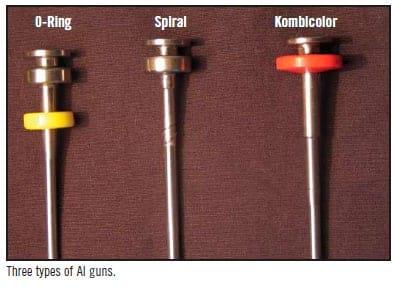
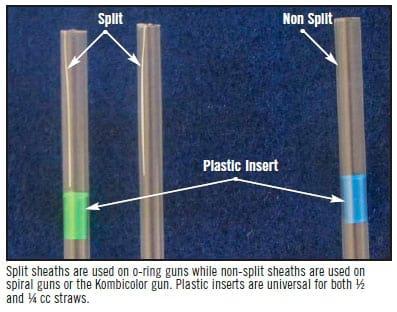
Breeding Sheaths - Sheaths not only vary in the straw size they were designed to accommodate, but also in the locking method for securing the gun and sheath together. All sheath types are available in bulk or individually packaged.
Locking mechanisms
• Split sheathes are designed for use with O-ring guns.
• Non-split sheaths are designed for use with spiral or Kombicolor guns.
• Non-split sheaths are designed for use with spiral or Kombicolor guns.
Straw Size
• Sheaths without plastic inserts are exclusively for use with ½ cc straws.
• Sheaths with plastic inserts will accommodate both ¼ and ½ cc straws
• Sheaths with plastic inserts will accommodate both ¼ and ½ cc straws
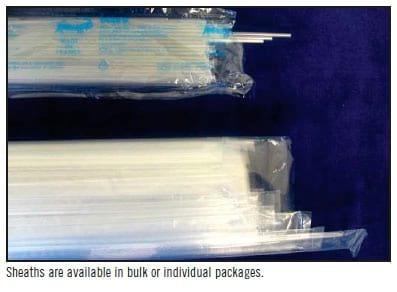
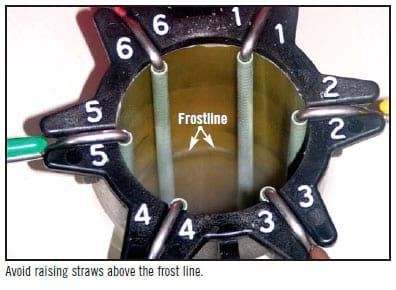
EQUIPMENT MAINTENANCE
• Store your nitrogen semen tank on a wooden pallet in a dry environment. The nitrogen use rate of your semen storage tank should be measured periodically. If a tank is losing efficiency, it should be replaced.
• Dial thermometers for the thawing bath are typically recommended because they are inexpensive yet durable. However, they must be periodically checked against a standard mercury or alcohol thermometer to confirm correct calibration.
• Sheaths left in extremely hot places such as the dash of an automobile will warp and expand. Extremely cold sheaths may crack and shatter when loading the gun. Damaged sheaths should not be used.
• Never use an O-ring gun without the O-ring.
• After each day's use, empty water from thaw bath and wipe completely dry.
• Keep equipment kit clean and dry.
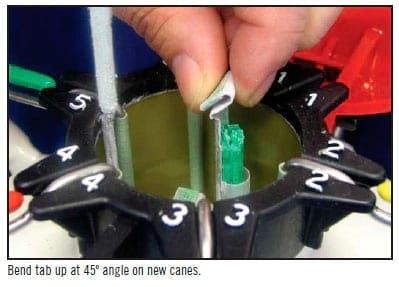
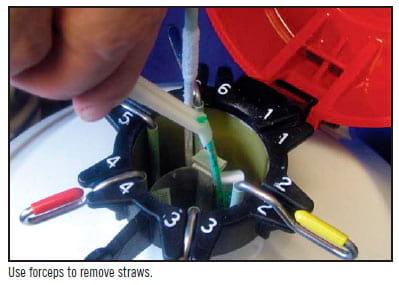
STRAW RETRIEVAL & THAWING
• Remove the canister from its storage position and raise it until the cane tops are two to three inches below the top opening of the tank. Avoid raising straws above the frostline.
• Locate the cane you want. On new canes, bend the identification tab up to a 45º angle.
• Use the forceps to remove one straw at a time from the top goblet. If it takes more than 10 seconds to retrieve the straw, lower the canister back into the tank and allow to re-cool for 20 to 30 seconds.
• Once removed from the tank, shake the straw gently to remove excess liquid nitrogen remaining in the cotton-plug end and promptly place in 95º F (35º C) water to thaw for at least 45 seconds.
• A rule of thumb is to thaw only as many straws as you can use in 10 to 15 minutes. Should you encounter problems, a 15 to 20 minute interval between thawing and insemination will not lower semen quality a great deal. However, be sure to maintain the straw temperature near 95º F (35º C) throughout the semen handling process.
• After all straws from the top goblet have been used, remove the goblet from the cane and discard it.
• To retrieve straws from the bottom goblet, grasp the cane and raise it until the straws are even with other cane tops. Hold the cane and canister with one hand. With your forceps in the other hand, remove the desired straw and place it in the thaw water.
• When all the straws are used from the bottom goblet, remove and discard both the cane and goblet.
• Be sure to lower the cane of semen back into the canister to avoid dropping canes of semen into the bottom of the tank.
• Return the canister to its storage position immediately after straw removal.
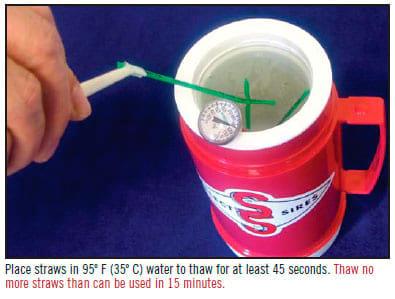
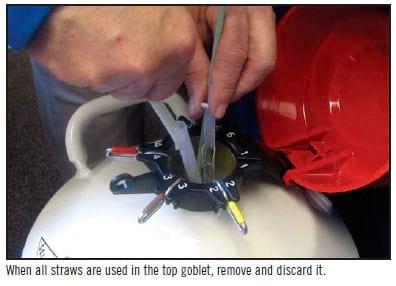
LOADING THE INSEMINATION GUN
• Choose a sheltered area for loading the guns and inseminating cattle to help curb undesirable semen temperature fluctuations.
• Partially remove a plastic breeding sheath from the container so it is easy to grasp when needed.


• Wash hands prior to loading guns.
• Before loading the insemination gun, pre-warm the barrel by stroking it vigorously with your hand five or six times.
• Make sure the plunger is back about six inches to allow for insertion of the straw.
• Remove the straw from the thaw water and wipe it completely dry with a paper towel.
• Check to see that the straw contains semen from the desired bull and that a small bubble is at the crimped end.
• If the bubble is not at the crimped end, gently tap the straw until the bubble moves to its correct position.
• If you cannot read the printing on the straw, do not use it. Ask your Select Sire representative for a replacement.
• Place the cotton plug end of the straw in the gun. It will stop at exactly the right depth.
• Note: When using ¼ cc straws in a universal gun it may be necessary to seat the straw on the plunger first, then gently push the straw into the gun, retracting the plunger.
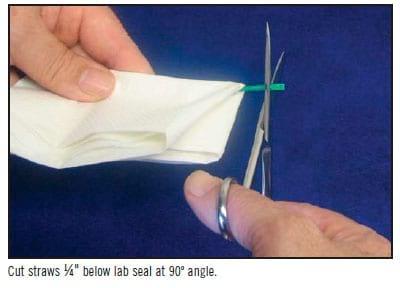
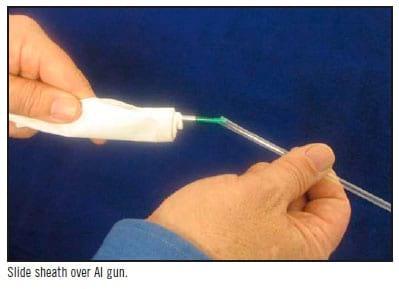
• Wipe the scissors with a paper towel and cut the straw ¼" below the lab seal. Make a right angle cut to the straw and be sure not to cut more than ¼" or the straw and sheath may not seal properly.
• Slide the plastic sheath over the straw and gun. When using sheaths with inserts, grasp the sheath near the insert and seat the straw into the insert, then slide the sheath over the gun. Firmly attach the sheath and gun together using the appropriate technique listed below:
• O-ring guns – make sure the O-ring is loose on the gun as the split sheath is passed over the gun and through the O-ring. Slide the O-ring toward the plunger end and lock sheath and gun together with a twisting motion.
• Spiral guns – a raised spiral and self-threading technique is used to lock non-split sheath and gun together with a twisting motion.• Kombicolor guns – non-split sheaths are manually forced over an enlarged flange on the shaft of the gun.
• Inspect the straw end of the gun to ensure a proper seal between sheath and straw and make sure no cracks exist in the sheath. If the seal is suspect, retighten and (or) replace sheath, which may require using scissors to cut the present seal between sheath and straw before they can be separated. Replacing the sheath in this manner may also become necessary should the sheath become hygienically contaminated before insemination.
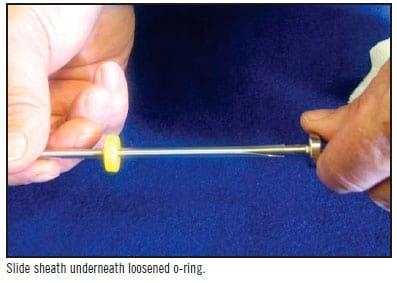

TEMPERATURE CONTROL AFTER THAWING
It is very important to maintain the 95º F straw temperature until semen is deposited in the cow. Temperature fluctuations must be avoided. During cold weather it will be extremely important to warm gun, sheaths, paper towels, etc, before they contact straws, while the opposite may be true during the warm summer months.
Tips and recommendations:
• Pre-warm sheaths and guns by placing them inside clothing prior to loading.
• Cover the gun tip with your hand to keep it warm during the loading procedure (Note: hand must be clean!).
• Wrap loaded guns in a paper towel or in a plastic sheath cover Slide sheath over AI gun. 5 (see below) to provide both thermal and hygienic protection and placed inside your clothing for transport to the cow.
• With the animal secured, your arm inserted in the rectum, and the vulva cleaned and open, quickly remove the gun from clothing and insert it into the vagina.
• Cover the gun tip with your hand to keep it warm during the loading procedure (Note: hand must be clean!).
• Wrap loaded guns in a paper towel or in a plastic sheath cover Slide sheath over AI gun. 5 (see below) to provide both thermal and hygienic protection and placed inside your clothing for transport to the cow.
• With the animal secured, your arm inserted in the rectum, and the vulva cleaned and open, quickly remove the gun from clothing and insert it into the vagina.
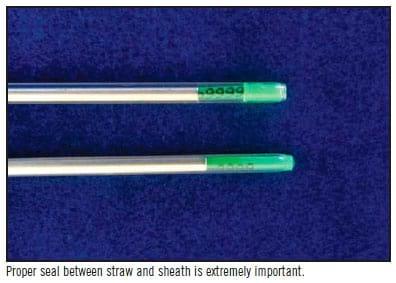
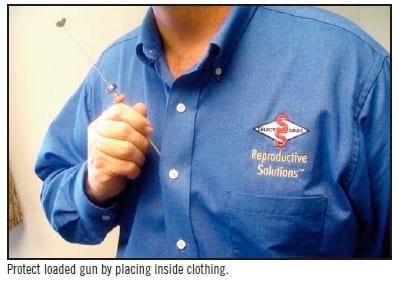
DOUBLE SHEATH INSEMINATION FOR DISEASE CONTROL
If vaginitis or ureaplasma is a diagnosed problem in your herd, individually packaged sheaths or disposable sheath covers may also be used in a double sheath insemination procedure. In addition to providing thermal protection, this procedure reduces the number of bacteria carried from the vagina into the uterus during insemination and may increase fertility.
Apply the following procedures when using a double sheath to breed cows.
• Keep the plastic sheath package on the loaded gun as you withdraw it from your shirt.
• Insert the double-sheathed gun through the vagina to the opening of the cervix.
• Pull the package back on the gun until the gun tip pops through the plastic.
• Pass the gun through the cervix.
• Rolled "Sanitary Sleeves" or "Sani-Shield" protectors can also be used to double sheath breed cows.
• Insert the double-sheathed gun through the vagina to the opening of the cervix.
• Pull the package back on the gun until the gun tip pops through the plastic.
• Pass the gun through the cervix.
• Rolled "Sanitary Sleeves" or "Sani-Shield" protectors can also be used to double sheath breed cows.
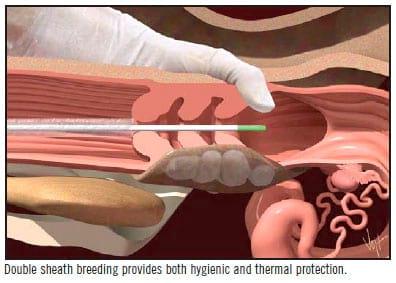
CLEAN UP
After insemination, there are several clean-up steps you will want to follow.
• Inspect the gun tip for signs of infection. Make a note for your veterinarian if you see any.
• Bend the sheath and straw tip at a 90º angle and remove these from the gun.
• Tighten the O-ring back on the gun so it will not get lost.
• Double-check the bull's identity on the straw.
• Reverse strip your glove so the straw, sheath, and manure are trapped inside. Squeeze out any excess air; tie a knot in the open end and dispose of the glove.
• Wipe the gun clean and dry it before retuning it to the insemination kit.
• If the gun becomes dirty after use, take it completely apart, wash with soapy water and rinse with clean water. Shake the gun to remove excess water, then allow it to completely dry before reassembly.
• Bend the sheath and straw tip at a 90º angle and remove these from the gun.
• Tighten the O-ring back on the gun so it will not get lost.
• Double-check the bull's identity on the straw.
• Reverse strip your glove so the straw, sheath, and manure are trapped inside. Squeeze out any excess air; tie a knot in the open end and dispose of the glove.
• Wipe the gun clean and dry it before retuning it to the insemination kit.
• If the gun becomes dirty after use, take it completely apart, wash with soapy water and rinse with clean water. Shake the gun to remove excess water, then allow it to completely dry before reassembly.
Strict adherence to the procedures described in this brochure will maximize the opportunity for success in your AI program. If you have questions about the correct handling procedures for Select Sires semen, please call your local Select Sires Reproductive Solutions Specialist.
Related topics
Authors:
Join to be able to comment.
Once you join Engormix, you will be able to participate in all content and forums.
* Required information
Would you like to discuss another topic? Create a new post to engage with experts in the community.
Create a post





